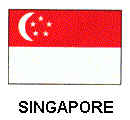
SINGAPORE - Weather
Mean daily temperature: 26.6 deg C
Mean daily maximum temperature: 30.7 deg C
Mean dality minimum temperature: 23.7 deg C
Highest maximum temperature: 35.8 deg C
Lowest minimum temperature: 19.6 deg C
SINGAPORE - Land use
Total land area (main and offshore islets): 618.1 sq. km
Built-up areas (including new industrial sites): 291.7
Farm holding areas (of licensed farms, excluding land occupied by pure
rubber and coconut plantations): 64.3 sq. km
Forest: 28.6 sq. km
Marsh and tidal waste: 21.1 sq. km
Others (inland waters, open spaces, Public Gardens, Cemeteries,
non-built-up areas in military establishments, quarries, rubber and
coconut plantations, and unused land): 212.4 Sq. km
SINGAPORE - Population
The population of Singapore at 30 June 1983 was 2,502,000. Compared
with 1982, the population increased by 30200 persons or 1.2%. The
population density rose from 3999 persons per sq. km in 1982 to
4048 persons per sq. km.
The chinese constituted 76.6% of the population, the Malays 14.7%, the
Indians 6.4% and persons of the other ethnic groups the remaining 2.3%.
SINGAPORE - Language
Malay, Chinese (Mandarin), Tamil and English are the official languages.
Malay is the national language and English is the language of
administration.
The main Chinese dialects are Hokkien, Teochew, Cantonese, Hainanese, Hakka
and Foochow. Mandarin is being increasingly used among the Chinese in
place of dialects. Telegu, Malayalam, Punjabi, Hindi and Bengali are
spoken by ethnic Indians.
SINGAPORE - History in brief
The original seaport of Temasek or Singapore was founded in 1927 as one
of the three kingdoms of the trading empire of Srivijaya, based in
Palembang, in southern Sumatra. It was destroyed in 1376 by the Majapahit
empire based in Java.
Modern Singapore was founded in 1819. Sir Stamford Raffles, in his search
for a new British commercial centre in the East, recognised its immense
potential as soon as he set foot on the island. Acting independently of the
government in Penang, he established a base here on behalf of the British
East India Company.
He secured a concession from Sultan Hussein Mohamed Shah and Temenggong
Abdu'r Rahman on 6 Feb 1819, for the establishment of a trading post on the
coast between Tanjong Malang and the Kallang River.
From 1819 until 1823, Singapore was a dependency of bencoolen. From 1823
to 1826, it was under the direct control of the Governer-General in India.
John Crawfurd, the Resident, concluded in 1824 the final treaty with the
Sultan and Temenggong of Johor which ceded Singapore to the East India
Company in full sovereignty.
In 1826, Singapore was joined with Penang and Malacca to form the Straits
Settlements under the general supervision of penang. In 1830, the Straits
Settlements were placed under the Government in Bengal.
In 1851, the settlements were removed from the administration of Bengal and
placed under the personal supervision of the Governor-General of India.
After the Indian Mutiny, 1857-1859, the government of India passed from the
East India Company to the India Office in London.
A commission, headed by Robinson, Governor of Hong Kong, to investigate the
fiscal position of the settlements, was in favour of a transfer of authority
and, in 1867, the Straits Settlements became a crown colony of British
intervention in the Malay States, the Governor of the Straits Settlements
doubled as High Commissioner of the Malay States.
The opening of the Suez Canal in 1869 increased Singapore's prosperity
and progress. In the wake of prosperity, the influential mercactile
community demanded a voice in the administration of the colony. It was
instrumental in spearheading significant changes in the workings of the
constitution. The bulk of the population prior to the outbreak of the
First World War were transients and were politically indifferent.
Singapore surrendered to the Japanese troops on 15 Feb 1942 and was under
Japanese occupation for three-and-a-half years. from 5 Sep 1945, when the
Japanese surrendered, the island was run by the British Military
Administration; civil adminstration was restored on 1 Apr 1946 and
Singapore was accorded a new status as a separate crown colony.
With the restoration of peace and resumption of commerce after the
Second World War, the people began to agitate for a greater involvement
in government. The first step towards self-government was taken in 1948 when
Singapore held its first elections for six seats out of the 22 in the
Legislative Council, with a majority of officials and officially appointed
members. The next step was taken in 1953 with the appoinment of the Rendel
Commission, whose recommendations were put into effect in 1955,
establishing a 32-member Legislative Assembly, of whom 25 were elected
from one-member constituencies.
In the general election, the Labour Front led by David Marshall won ten
seats, and with the support of the Alliance and two of the nominated
members Marshall formed the government.
In 1961, Tunku Abdul Rahman, Prime Minister of Malaya, put forward his idea
of a Greater Malaysia to consist of the Federation of Malaya, Singapore,
Brunei, North Borneo (now Sabah) and Sarawak. In spite of vehement opposition
from Indonesia, Malaysia was proclaimed on 16 Sep 1963, consisting of the
11 states of Malaya, and Singapore, Sabah and Sarawak.
Differences between the Malaysian and the Singapore governments on a
"Malaysian Malaysia" led to the separation of Singapore from the
federation on 9 August 1965.
Independent, sovereign Singapore was admitted to the United Nations on
21 Sep 1965, and became a member of the Commonwealth of Nations on
15 Oct 1965, sponsored by Malaysia. On 22 Dec 1965, Singapore became a
republic.